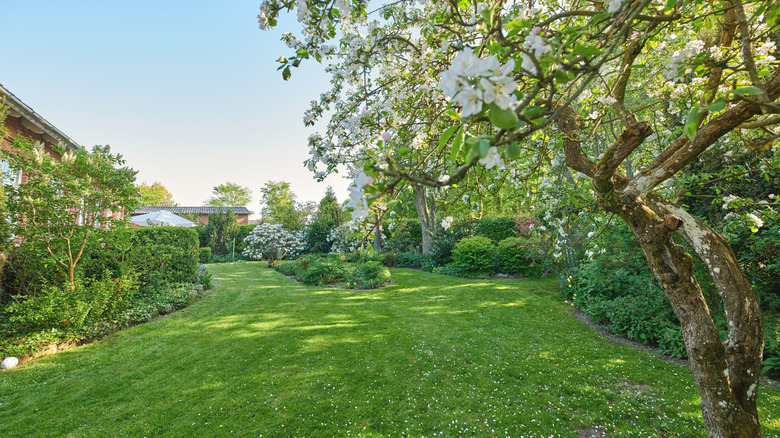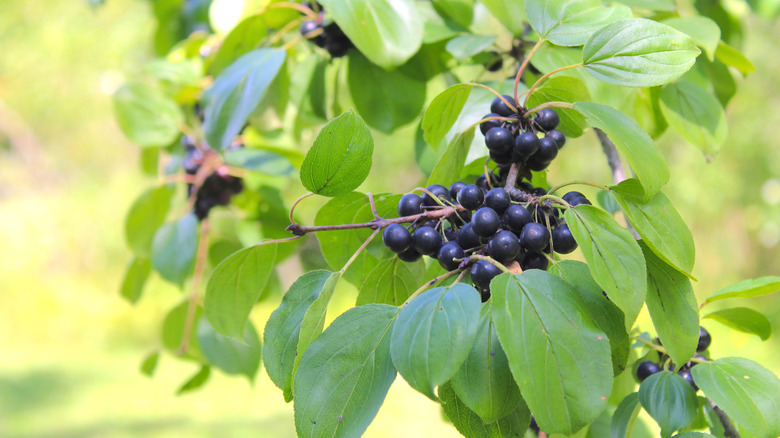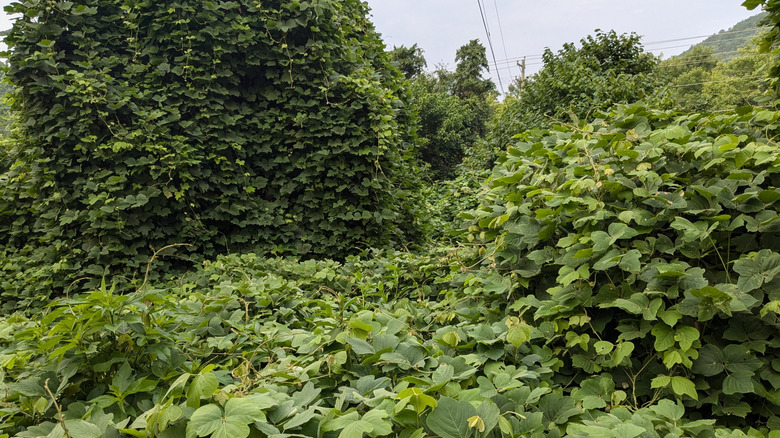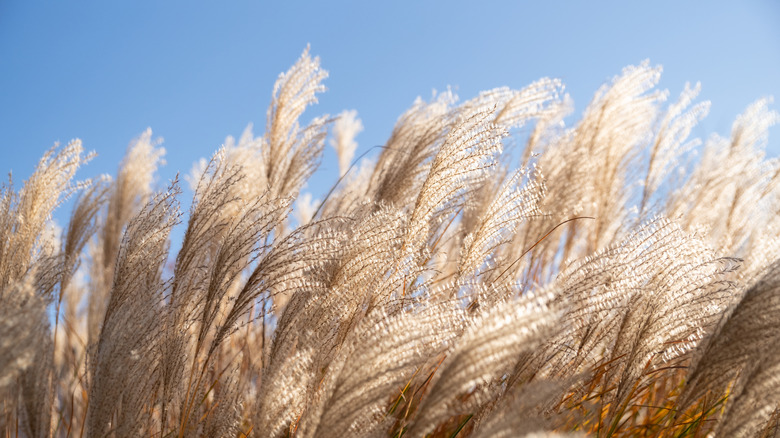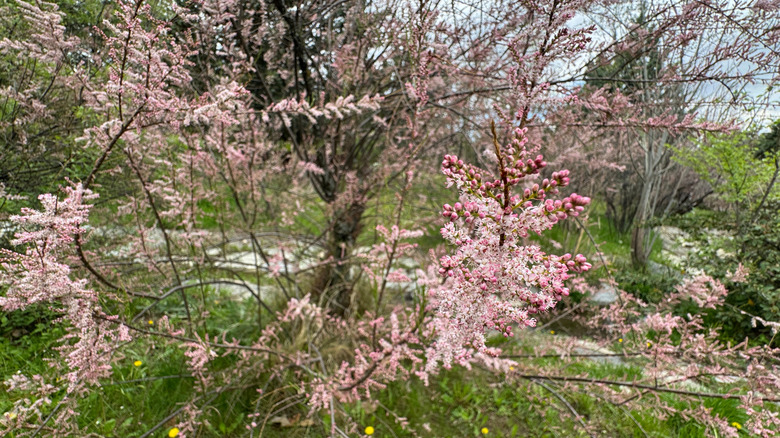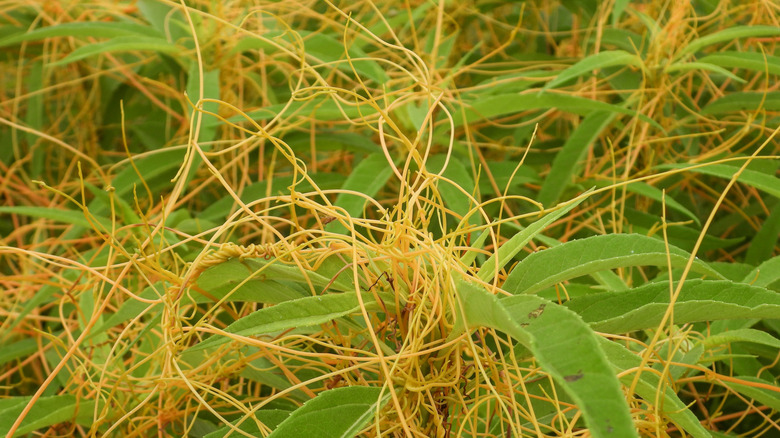What Is The Number One Most Invasive Plant In Your USA Region Today?
While many of us love new green additions in our yards and gardens, there are some plants we want to avoid, especially the invasive ones. These non-native intruders typically invade an area, taking away all of the nutrients, water, and sunlight from the nearby plants. Some of these nuisances even take over host plants, depleting them until they perish. These unwanted pests also cause issues to your soil and overall water quality. Unfortunately, there are more than 6,500 invasive species listed by the National Invasive Species Information Center, making it difficult to pinpoint the most egregious one in America, especially with how vast the country truly is. Instead, it's easier to name the worst in each region: buckthorn in the Northeast; kudzu vines in the Southeast; Chinese silver grass in the Midwest; salt cedar in the Southwest; and dodder in the West.
Luckily, invasive plants are monitored by many professionals, ensuring the safety of an environment. However, that doesn't mean they are monitoring every single property. Therefore it is important to identify and safely remove invasive plant species from your lawn and garden and to know which ones are the most invasive in your area. If you need help recognizing or even reporting an invasive species near you, visit EDD MapS, the Early Detection and Distribution Mapping System by the Center for Invasive Species and Ecosystem Health at the University of Georgia. There are also additional resources in case you need more information about the specific plant you've found.
Don't get taken over by buckthorn in the Northeast
Common buckthorn (Rhamnus cathartica) is a shrub that often overtakes native trees and plants in the Northeast region. After an infestation, it's hard to eliminate and adds too much nitrogen in the soil, affecting the growth of surrounding plants. These intruders can survive in many different soil types and sunlight conditions in USDA Hardiness Zones 2 through 7. You'll recognize a buckthorn tree by its brown peeling bark, dark green, elliptical-shaped leaves, and small, yellowish flowers. While many bird populations eat the fruit off of female varieties, you don't want to plant this small tree in your yard, especially since it is illegal to sell, transport, and distribute this noxious plant in many states.
There are a few ways to eradicate these unwanted pests, including removal, chemical solutions, or burning. For smaller versions of this noxious shrub, you can remove them by carefully pulling by hand or by cutting the stem. Immediately follow up by covering the leftover stump, so it doesn't re-sprout. Make sure to burn the clippings and seeds and clean your tools and clothes immediately. Complete the task by spraying a herbicide; just remember to safely follow all of its directions.
Overall, the fastest most efficient way to handle large buckthorn infestations is to treat them with a combination of cutting, pulling, and even burning and herbicides. However it doesn't end there, you'll need to annually treat the area for a few years as part of its long-term management process.
Immediately resolve kudzu vines in the Southeast
As an invasive vine you should avoid growing, kudzu (Pueraria montana var. lobata) will quickly overrun your garden and yard, taking all the space and available resources, including water, sunlight, and nutrients. This depletion will then affect your other plants, causing growth issues and even death. Originally planted in the South to control soil erosion and as an ornamental landscaping feature, this dense, green vine quickly took over, crowding out everything in its wake. Kudzu survives the best in zones 5 through 10 with permeable soil that isn't moist alongside ample amounts of sunlight. These fast-growing invaders are also known to damage buildings and utility poles, making it a green horror show you need to keep far away from.
Don't sit around if you find this intrusive vine on your property because they can grow about a foot a day and over 100 feet in total. If the infected area is small enough, you can remove it on your own, cutting it with your lawn mower and burning the clippings. If you have livestock, such as goats, it is safe for them to eat the weed, giving your larger property a natural mow. Follow up by applying a herbicide to more persistent areas, but make sure to follow all of the directions thoroughly. While this plant is a pretty, ornamental piece, it is illegal to distribute and sell in many states, including Texas, so think twice before giving this beauty a try in your yard.
Steer clear of Chinese silvergrass in the Midwest
Chinese silver grass (Miscanthus sinensis) is a silvery, long grass that has pink to silver flowers. In zones 5 through 9, this unwanted addition thrives in sunny spots with moist yet well-drained earth. This invader is an aggressive species that will take over an area, changing the soil structure and crowding out native plants. To make matters worse, many midwest states such as Minnesota and Nebraska experience wildfires, and Chinese silver grass is extremely flammable, easily igniting during this time of year. This can put you and your home in even more danger. Therefore, you need to get rid of it immediately.
However, don't be alarmed if you see this variety for sale in other parts of the U.S. There are sterile cultivar options, such as Cabaret (Miscanthus sinensis var. condensatus), that can actually be planted in gardens. But only grow one if you live in a different region so accidental spreading doesn't happen. Also you should never place them near wildland areas in case it spreads.
Keep in mind that even ornamental options are known to escape gardens and landscaping, venturing out and infesting other areas. Therefore, most people opt to keep it off their property altogether. If you do notice this intruder on your Midwestern property, apply herbicides right away. Also bag it up before disposal or burn any leftover pieces. You may need to monitor or reapply a chemical solution for tricky or larger areas.
Watch out for salt cedar in the Southwest
While absolutely stunning to gaze upon, salt cedar (Tamarix ramosissima) is an invasive plant you should never grow in Southwest states, such as Texas. Hardy in Zones 2 through 8, they prosper in full sun and well-drained yet moist loam. As a small shrub that prefers wet environments like rivers and stream beds, they have small pink flowers that droop from its twiggy branches and cedar-like leaves.
Once they take root in this region, it forms dense thickets, overtaking the area and depleting water and other nutrients from the native species. But, that's not all: these plants can reshape a river channel, reducing banks and water quality, which then causes issues to the local habitat. Since seeds can be viable for a while and the excretion of salt alters the soil and its surroundings, you need to remove this plant immediately. And if you live in fire-prone states, these weeds only add more fuel due to high levels of dead, dry branches and twigs.
The best way to combat these intruders, especially if you have a large water feature on your property, is to apply herbicide solutions and sometimes combine it with livestock grazing control for larger infestations. While not necessarily nutritious for cows and goats, the animals can help remove ground foliage while herbicides penetrate down to deep roots, helping remove problem zones. These plants love sun, so you can lower the plant's chances of popping up in your area by having ample amounts of shade in your yard.
Dodder is the West's nemesis
An invasive species you should keep out of your garden at all costs in the West are dodder (Cuscuta spp.) weeds. They're easily identified by their stringy yellow or orange stems that wrap around their prey. These intruders mosey on into yards, pastures, and sometimes even gardens through heavy machinery, gardening tools, clothing, animals, irrigation, or weather. Flourishing in zones or 4 through 11, they are considered hardy and able to withstand high humidity and dry areas.
You never want to leave dodder plants to their own devices. Sucking nutrients and water from the surrounding host plants, it will overrun and kill all of your plants and lawn. Removal involves pruning and detangling it from the host plant and burning any residue. You also can bag up the bits and pieces, throwing them away. Remember to pick up any seeds because they can lay dormant for decades before they come back with a vengeance. If the host plant is still in good condition, you can sometimes save it by pruning affected leaves and stems, but dodder typically takes over before you have the chance to be a hero. Once you finish the removal, you'll need to monitor the spot and apply herbicides to ensure no new plants bloom. With any solutions you use, always follow the instructions. To prevent dodder from taking over your property, only use dodder-free seeds and clean all machinery and gardening tools, especially if anyone has borrowed them.
